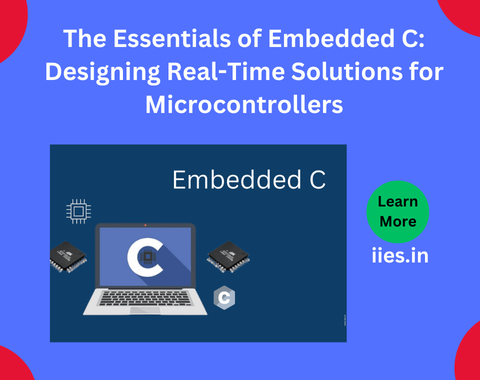
Embedded C is a specialized version of the C programming language tailored for programming embedded systems, offering features that enable low-level hardware control and enhanced management of system resources, making it well-suited for applications prioritizing performance and efficiency.
They are typically used to build microcontroller-based applications. These extensions include I/O fixed-point arithmetic, hardware addressing, address space access, and more.
Key Features:
Embedded C plays an important role in embedded systems development for several reasons:
Direct Hardware Control: Embedded C provides the ability to directly manipulate hardware components. This low-level access is essential for tasks such as reading sensor data, controlling motors, and managing communication protocols.
Efficiency and Performance: Embedded systems often have limited processing power and memory. Embedded C is designed to minimize resource usage and create efficient code that allows for faster execution and reduced power consumption, which is important for battery-powered devices.
Real-time Capability: Many embedded applications require real-time processing to respond to external events within tight timelines. Embedded C supports the development of real-time systems, ensuring timely responses and reliable operation.
Portability and flexibility: Although Embedded C is tailored to specific hardware, it offers a degree of portability across different platforms. This allows developers to adapt their code to different microcontrollers without significant rewriting, making upgrades and modifications easier.
Robustness and stability: Embedded C promotes the development of robust code that can handle hardware failures and unexpected conditions. This is crucial for safety-critical applications such as automotive and medical systems, where reliability is paramount. Integration with development tools: Embedded C is widely supported by a wide range of integrated development environments (IDEs) and debugging tools. This ecosystem helps developers write, test, and optimize their code more efficiently.
Community and resources: Embedded C has a large community of developers and extensive resources, meaning programmers can find libraries, frameworks, tutorials, and forums to help them reduce development time and improve knowledge sharing.
Foundation for modern technologies: As the backbone of many IOT devices and intelligent systems, Embedded C is an essential part of the development of modern technologies and therefore crucial to innovation in areas such as automation, robotics, and consumer electronics.
When getting started with Embedded C, it’s important to have the right development tools and a good IDE (Integrated Development Environment). Here is a guide to some recommended tools and IDEs.
1. Keil MDK
Description: A popular IDE for developing ARM microcontrollers.
Features: Integrated development environment with a powerful code editor. Debugger for real-time debugging and performance analysis. Extensive library and middleware support.
Best for: Beginners and experts using ARM Cortex-M microcontrollers.
2. MPLAB X IDE
Description: Developed by Microchip Technology for PIC and dsPIC microcontrollers.
Features: Cross-platform support (Windows, macOS, Linux). Embedded support for a range of Microchip development tools. Advanced debug options and simulators.
Best for: Developers using Microchip’s PIC microcontrollers.
3. IAR Embedded Workbench
Description: Highly optimized IDE for embedded development across a range of architectures. Features:
Powerful C/C++ compiler optimized for performance and size. Comprehensive debugging tools. Supports a wide range of microcontrollers and development boards.
Ideal users: Professionals who require a robust, high-performance development environment.
4. Eclipse and Embedded C/C++ Development Tools (CDT)
Description: A versatile open-source IDE that can be configured for embedded development.
Features:
Highly customizable with a wide range of plugins.
Supports a wide range of microcontroller toolchains.
Excellent community support and documentation.
Bestfor:Developerslookingforafreeopen-sourcesolution.
5.Arduino IDE
Description: An easy-to-use IDE primarily for Arduino boards.
Features: Simple user interface, perfect for beginners. Comprehensive library support for a wide range of sensors and modules. Built-in examples and community-driven resources. Best for: Hobbyists and beginners who want to experiment with embedded systems.
Download the IDE: Go to the official website of your chosen IDE and download the latest version.
Install the IDE: Follow the installation instructions on the website. Most IDEs come with a simple installation wizard. Set up the tool chain: Depending on your IDE, you may need to install a specific compiler tool chain. For example, Keil uses its own compiler, while MPLAB uses the XC compiler for PIC devices.
Connect the hardware: If you’re using a development board, make sure it’s connected to your computer via USB. If prompted, install the necessary drivers.
Create a new project: Open the IDE and create a new project. Select the appropriate microcontroller or development board. Write the code: Start coding your embedded C application. Most IDEs provide sample projects to help you get started.
Indian Institute of Embedded Systems – IIES